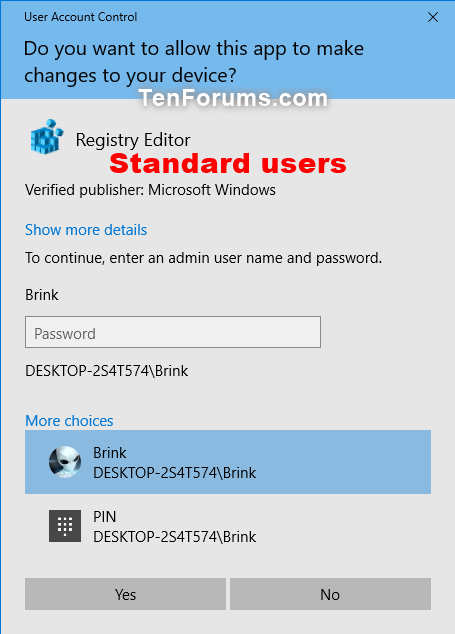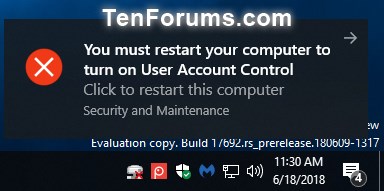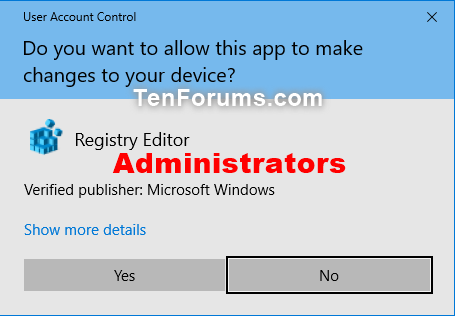How to Enable or Disable User Account Control (UAC) in Windows
When User Account Control (UAC) is enabled, Windows prompts for consent or prompts for credentials of a valid local administrator account before starting a program or task that requires a full administrator access token. This prompt ensures that no malicious software can be silently installed or run.
With the Always notify or Default UAC setting enabled, your desktop will be dimmed and switched to the secure desktop when you get an elevation request by the User Account Control (UAC) prompt.
A user that is a member of the Administrators group can log on, browse the Web, and read e-mail while using a standard user access token. When the administrator needs to perform a task that requires the administrator access token, Windows 10 automatically prompts the user for Y/N approval. This prompt is called an elevation prompt for UAC consent prompt.
The user experience for standard users is different from that of administrators in Admin Approval Mode. The recommended and more secure method of running Windows 10 is to make your primary user account a standard user account. Running as a standard user helps to maximize security for a managed environment. With the built-in UAC elevation component, standard users can easily perform an administrative task by entering valid credentials for a local administrator account. The default, built-in UAC elevation component for standard users is the UAC credential prompt.
See also: How User Account Control works (Windows 10) | Microsoft Docs
The User Account Control: Run all administrators in Admin Approval Mode security policy determines the behavior of all User Account Control (UAC) policies for the entire system. This is the setting that turns UAC on or off.
This tutorial will show you how to enable or disable User Account Control (UAC) for all users in Windows 7, Windows 8, or Windows 10.
You must be signed in as an administrator to enable or disable User Account Control (UAC).
Enabling UAC using the method in this tutorial will not enable UAC for the built-in Administrator account.
Disabling User Account Control (UAC) will put your computer at a higher security risk.
Contents
- Option One: Enable or Disable User Account Control (UAC) in Local Security Policy
- Option Two: Enable or Disable User Account Control (UAC) using a REG file
EXAMPLE: User Account Control (UAC) prompt when enabled

The Local Security Policy is only available in the Windows 7/8/10 Pro, Windows 7/8/10 Enterprise, and Windows 10 Education editions.
All editions can use Option Two below.
1 Open the Local Security Policy (secpol.msc).
2 Expand open Local Policies and Security Options in the left pane of Local Security Policy, and double click/tap on the User Account Control: Run all administrators in Admin Approval Mode policy to edit it. (see screenshot below)
3 Do step 4 (enable) or step 5 (disable) below for what you would like to do.
This is the default setting.
A) Select (dot) Enabled, click/tap on OK, and go to step 6 below. (see screenshot below)
6 When finished, close the Local Security Policy window.
7 Restart the computer to apply. (see screenshots below)

The downloadable .reg files below will modify the DWORD value in the registry key below.
HKEY_LOCAL_MACHINE\SOFTWARE\Microsoft\Windows\CurrentVersion\Policies\System
EnableLUA DWORD
0 = Disable
1 = Enable
1 Do step 2 (enable) or step 3 (disable) below for what you would like to do.
This is the default setting.
A) Click/tap on the Download button below to download the file below, and go to step 4 below.
Enable_UAC.reg
Download
A) Click/tap on the Download button below to download the file below, and go to step 4 below.
Disable_UAC.reg
Download
4 Save the .reg file to your desktop.
5 Double click/tap on the downloaded .reg file to merge it.
6 When prompted, click/tap on Run, Yes (UAC), Yes, and OK to approve the merge.
7 Restart the computer to apply. (see screenshots below)

8 You can now delete the downloaded .reg file if you like.
That's it,
Shawn
Related Tutorials
- How to Enable or Disable User Account Control (UAC) prompt for Built-in Administrator in Windows
- How to Change User Account Control (UAC) Settings in Windows 10
- How to Change User Account Control (UAC) prompt Behavior for Administrators in Windows
- How to Change User Account Control (UAC) prompt Behavior for Standard Users in Windows
- How to Hide or Show Administrators in UAC prompt for Standard Users in Windows
- How to Enable or Disable Dimmed Secure Desktop for UAC prompt in Windows
- How to Enable or Disable Ctrl+Alt+Delete Secure Desktop for UAC prompt in Windows
- How to Create Elevated App Shortcut without UAC Prompt in Windows 10
Enable or Disable User Account Control (UAC) in Windows
-
New #1
The following articles explain why UAC, a fundamental component of Microsoft's overall security vision, should not be disabled.
Why You Shouldn’t Disable User Account Control (UAC) in Windows
What is UAC (User Account Control) and why you should never turn it off | Digital Citizen
-

Enable or Disable User Account Control (UAC) in Windows
How to Enable or Disable User Account Control (UAC) in WindowsPublished by Shawn BrinkCategory: User Accounts
03 Nov 2019
Tutorial Categories


Related Discussions







 Quote
Quote
